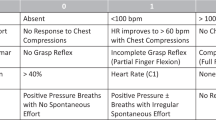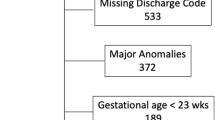Abstract
Trends in incidence and neonatal outcome following low Apgar scores (1 min Apgar score <6) were prospectively studied during the years (1981, 1983, 1986 and 1988. The incidence of birth asphyxia was 7.6% of live births during the study period; it was 5.8% in 1981, increased to highest of 8.9% in 1986 with slight reduction to 7.2% in 1988. Birth weight distribution of asphyxiated babies and 1 min Apgar score <3 (severe asphyxia) remained unchanged. A significant decline in neonatal mortality with asphyxia was noted from 46.0% to 28.4% during 1981 and 1988 respectively. Aetiological factors for asphyxia could be identified in nearly 90% of infants during 1988, and all but 2 of 12 factors studied registered significant differences from control non-asphyxiated group.
Similar content being viewed by others
References
Ghosh S, Bhargava SK, Saxena HK et al. A study of perinatal mortality with reference to maternal, fetal and neonatal factors from a clinical, biochemical, bacteriological and pathological point of view.ICMR Report 1972.
Singh M. Hospital based data on perinatal and neonatal mortality in India.Indian Pediatr 1986; 23: 579–584.
Batra A, Sen Gupta A, Kumar A et al. A study of birth asphyxia.J Obstet Gynecol India 1988; 38: 162–166.
Finer NN, Richard RT, Peters KL. Hypoxic ischemic encephalopathy in terms neonates: perinatal factors and outcome.J Pediatr 1981; 98: 112–117.
Singh M, Kalra V. Outcome of neonates with severe birth asphyxia.Indian Pediatr 1978; 158: 835–839.
Merchant RH. Birth asphyxia-predictor of outcome and management.Indian J Pediatr 1985; 52: 609–614.
Bhakoo ON, Khajuria R, Desai A et al. Lessons from improved survival at Chandigarh.Indian Pediatr 1989; 26: 234–240.
Chaturvedi P, Shah N. Maternal and obstetrical risk factors in asphyxia neonatorum.J Obstet Gynecol India 1989; 39: 499–503.
David RJ, Siegel E. Decline in neonatal mortality, 1968 to 1977: better babies or better care?Pediatrics 1983; 71: 531–535.
CyrRonald M, Usher RH, Mcclean FH. Changing patterns of birth asphyxia and trauma over 20 years.Am J Obstet 1984; 148: 490–499.
Sykes GS, Milloy PM, Johnson P. Do apgar scores indicate asphyxia?Lancet 1982; 1: 494–496.
Drage JS, Kennedy C, Berendes H et al. The Apgar score as an index of infant morbidity.Dev Med Child Neurol 1960; 8: 141–145.
Chowdhary J, Narang A, Bhakoo ON. Study of biochemical asphyxia at birth.Indian Pediatr 1987; 24: 63–68.
Bruinse HW, Reuwer PJHM. Predicting fetal distress.Indian J Pediatr 1989; 56: 451–454.
Fitzhardinge PM. Follow-up studies of the high-risk newborn. In: Avery GB, ed..Neonatology-Pathophysiology and Management of the Newborn, 3rd edn. Philadelphia: JP Lippincott Co, 1987: 413–415.
Robertson NRC. Resuscitation of the newborn. In: Robertson NRC, ed.Textbook of Neonatology, 1st edn, UK: Churchill Livingstone, 1986: pp 247–248.
Donn SM, Naglie RA. Prevention of post asphyxial hypoxic ischemic encephalopathy.Indian J Pediatr 1986; 53: 573–578.
Fisher DE, Paton JB. Resuscitation of the newborn infant. In: Klaus MH, Fanaroff AA, eds.Care of the High-risk Neonate, 3rd edn, Philadelphia. WB Saunders Company, 1986: pp. 43–44.
Jain S, Singhal PK, Saili A et al. Neonatal outcome in low risk women, admitted in 2nd stage of labour.J Obstet Gynecol India 1989; 39: 495–499.
Naeye RL, Peters EC, Bartholomew M. et al. Origins of cerebral palsy.Am J Dis Child 1989; 143: 1154–1161.
Author information
Authors and Affiliations
Rights and permissions
About this article
Cite this article
Kumari, S., Sharma, M., Yadav, M. et al. Trends in neonatal outcome with low apgar scores. Indian J Pediatr 60, 415–422 (1993). https://doi.org/10.1007/BF02751205
Issue Date:
DOI: https://doi.org/10.1007/BF02751205




